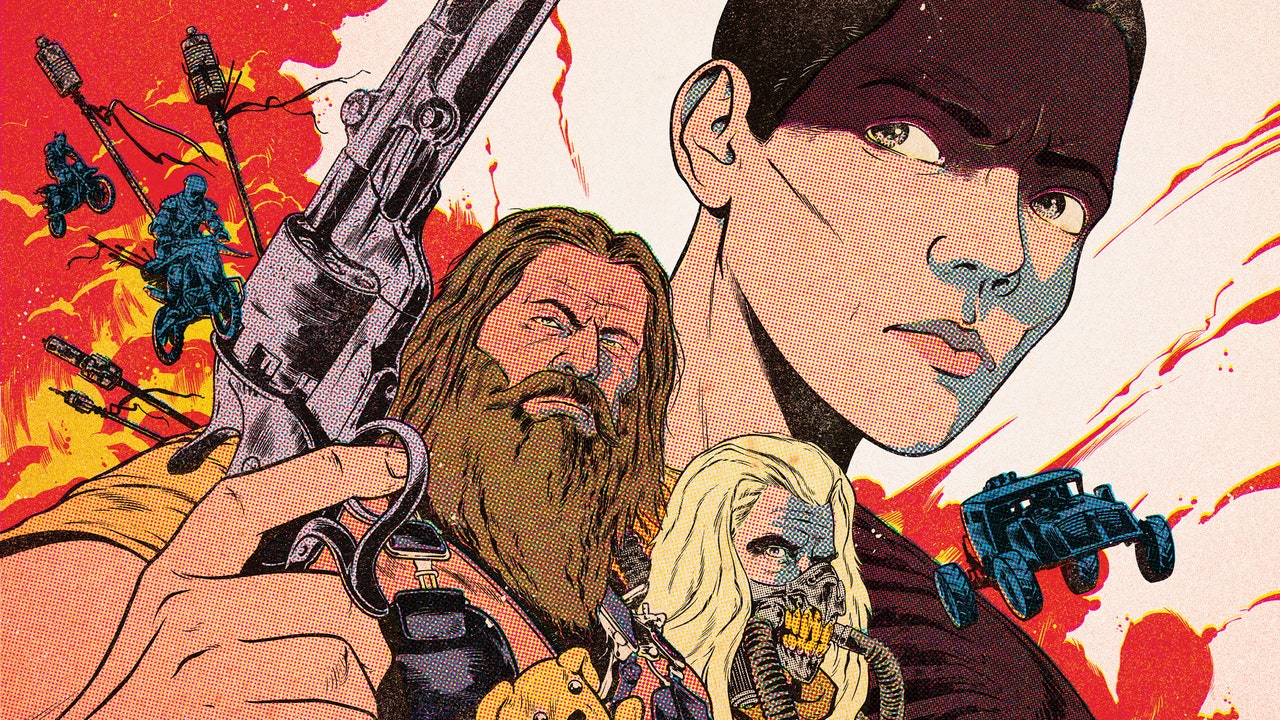The last time we saw Imperator Furiosa, in the dystopian chase thriller “Mad Max: Fury Road” (2015), she had just returned from the heat of battle, her face streaked with blood, one eye swollen shut, her body so fatigued and battered that she could hardly stand. Furiosa, played by a stupendous Charlize Theron, had spent several days and nights driving an enormous truck, the War Rig, across miles of open desert, withstanding fiery assaults, a lethal sandstorm, and the surly company of a reluctant ally named Max (Tom Hardy). But triumph, at last, was hers: the vile warlord Immortan Joe (Hugh Keays-Byrne) lay dead at her feet, and hundreds of newly liberated desert dwellers were erupting in celebration. Amid the chaos, Furiosa scanned the crowd for Max and caught him slinking away. For a moment, he looked back and gave her an approving nod—then turned and vanished into the throng.
On one level, this is how all the “Mad Max” movies have ended: with Max going it quietly alone, moving on to his next infernal adventure. The Australian writer and director George Miller conceived the character—played, in the first three films, by a broodingly effective Mel Gibson—as a classic loner antihero in a near-future verging on social and economic collapse. The original “Mad Max” (1979), Miller’s scrappily potent début feature, introduced Max as a police officer behind the wheel of a black muscle car, prized for his skill at pursuing lawbreakers at high speeds. Personal tragedy brought Max low and turned him loose; his wife and young child were murdered by an outlaw biker gang, and, even after he avenged them, grief and rage had clearly destroyed any lingering hope of human connection. By the arrival of a sequel, “The Road Warrior” (1981), Max had become a gun-for-hire nomad, driving across a vaguely Australian landscape, where every highway was a potential battlefield. He might still join a fight or a noble cause, but only if the price was right, and with no promise of loyalty. Now, and in the following film, “Mad Max Beyond Thunderdome” (1985), his only aims were to survive and keep moving.
Why, then, did Max’s exit in “Fury Road” trigger such an onrush of emotion? The answer is Furiosa. For once, Max had met his match in road warriorship—an equally skilled driver, a better sniper, and a fellow avatar of taciturn grit. There were differences, too: Furiosa had lost her left arm in unexplained circumstances, and did her driving and fighting with the aid of a robotic limb. Crucially, unlike Max, she was invested in something more than personal survival. The plot of “Fury Road” was set in motion by her decision to free Immortan Joe’s five young “wives” from sexual bondage, a gesture that turned out to be anything but casual or blandly altruistic. Furiosa, we learned, had been born into—and kidnapped from—a matriarchal society called the Vuvalini, a lost sisterhood to which she desperately wished to return. For all her battle-hardened toughness, she was, in Theron’s fiercely felt performance, very much a child longing for home.
She was also a reminder that a life scarred by tragedy need not be doomed to nihilistic solitude, and that made her a moral counterweight to Max. One of the thrills of “Fury Road” was its willingness to interrogate and even disrupt the long-standing foundations of the series. In taking up a new question—how would women cope with the end of a world dominated and destroyed by men?—Miller ingeniously remapped his own dystopia and tapped into fresh reserves of audience pleasure. When Max passed his rifle to Furiosa and invited her to take a difficult shot, conceding her superior marksmanship, we watched as one hard-bitten hero passed his baton to the next. Or, because this asphalt-hungry franchise was built for vehicular metaphors, we watched as Max took a back seat in what had looked, until then, like his story alone.
Now, nine years on from “Fury Road,” Miller brings us a “Mad Max” film in which Max himself is almost entirely absent. Miller says that he will be back, likely still played by Hardy, in future sequels, but the new movie, “Furiosa: A Mad Max Saga” is a prequel, filling in Furiosa’s origin story. (Miller co-wrote the script, with Nico Lathouris.) Unfolding like the darkest of fairy tales, it recounts how a girl, mesmeric of gaze and flinty of spirit, is stolen from her home and forever transformed, through a crucible of unrelenting physical and psychological brutality. At one point, the director considered having Theron reprise the role of Furiosa, using digital de-aging effects. He ended up casting two younger actresses instead: Alyla Browne plays her as a child, and Anya Taylor-Joy plays her as a young woman.
The tale begins, post-apocalypse, in the Green Place of the Many Mothers, a lush oasis tucked away amid towering desert dunes. Here dwell the Vuvalini, who have taken refuge from a world ravaged by oil wars, environmental blight, and unceasing violence. One of the first things you notice is that the young Furiosa (Browne) is already named Furiosa; it isn’t some moniker she acquired after plowing her pickup truck into the school prom. It’s the name she was presumably given by her mother, Mary Jabassa (Charlee Fraser), who must have sensed her daughter’s ferocity in the womb—or who knew that, whatever the child’s temperament, such a name might well armor her against a world defined by rage.
“Furiosa,” in other words, is both an end-of-days thriller and an Edenic parable, Revelation and Genesis rolled into one. The first thing we see the young Furiosa do is pluck a piece of fruit, signalling an imminent fall from grace. Within moments, she is kidnapped by male marauders on motorcycles, who tie her up and whisk her off into the burnt-orange desert. Mary valiantly gives chase, but her pursuit ends in brutal defeat, and Miller distills the horror of mother-daughter separation into a single devastating shot—a near-crucifixion, to continue the religious imagery—seared, with a diabolical flourish, into Furiosa’s ultra-magnified pupil. She will spend the rest of the film seeking revenge against her captors, specifically their leader, Dementus (Chris Hemsworth), a swarthy, malevolent warlord whose most prized and perverse accessory is a Teddy bear, usually worn dangling from his leather gear. Don’t suffer the little children to come unto him.
Dementus’s voice, equal parts merriment and menace, is recognizably Hemsworth’s, though the actor’s features have been obscured by a mangy beard and a bulbous prosthetic schnoz; without them, perhaps, he might have looked a bit too much like his most famous character, Thor, gone to goth-biker seed. In time, Dementus and his gang will forge a most unholy alliance with the young Immortan Joe (Lachy Hulme), who huffs and puffs through a mask of rotted metal that resembles the world’s grodiest CPAP machine. Immortan Joe oversees a mighty desert citadel, where he is served by fanatical young followers known as War Boys: you may remember them from “Fury Road,” screaming, “I am awaited in Valhalla!” right before they hurled themselves, like suicide bombers, to a fiery doom. Higher up in the ranks are various unsavories with names like Scrotus, Rictus Erectus, the People Eater, the Organic Mechanic, and the Bullet Farmer. Even after two viewings of “Furiosa,” I confess that I can scarcely tell these grotesques apart, let alone make sense of their roles within Immortan Joe’s fascist circle. It’s of little consequence; one way or another, Furiosa, lusting for freedom and revenge, will outwit them all.
She will accomplish this, in part, by disguising herself as a boy and working undercover in Immortan Joe’s hellish garage, where construction of the War Rig is under way. It’s around this time that Anya Taylor-Joy steps into the role—in one of the most seamless actor-to-actor transitions I can remember—and shows us Furiosa’s way forward: through an apprenticeship of flame and steel, carried out in the company of dangerous men. In passing herself off as one of them, Furiosa buries her femininity and hones her mechanical skills, like an antipodean Mulan. But Mulan, stealth gender bender though she was, ultimately undertook her deception to serve an empire. Furiosa means to subvert one—to escape it and, in the end, destroy it from within.
Women haven’t always held such a powerful or prominent place in Miller’s films. The sole memorable female character in the first “Mad Max” was Max’s wife, Jessie (Joanne Samuel), who dotes on her cop husband and worries constantly for his safety. Their moments together with their son at a seaside retreat are almost sacred in their sense of domestic contentment: “Crazy about you,” Jessie coos to Max as he heads out on his next perilous mission. Watch that exchange again and see how the tenderness of their marital rapport corresponds to the relative lushness of the scenery: the ocean waves lapping at the shores, the greenery outside their window. The apocalypse, for now, is still a work in progress. In time, there will be only dirt and gravel and dust—and Max’s aching memories of Jessie and their son.
Like a jalopy of jammed-together old parts, “Mad Max” was assembled from several influences: classic Westerns, Buster Keaton stunts, Chuck Jones’s Road Runner cartoons, the 1973 oil crisis. Another key inspiration: before Miller became a filmmaker, he was a doctor, and the horrific injuries he witnessed in the emergency room, many the result of car crashes, did their part to fire his imagination. For a newbie director, practicing medicine on the side doubtless had its financial as well as creative uses. Miller’s hospital work helped replenish the indie coffers; Max derives his surname, Rockatansky, from the nineteenth-century Austrian physician Carl von Rokitansky, who pioneered a method of examining organs at autopsies to determine the cause of death. An appreciation for viscera certainly suffuses the series, but what you remember from a “Mad Max” movie isn’t the extremity of the carnage; it’s the breathtaking clarity of the action. That quality, too, derives from Miller’s scientific mind. You sense in all his work a continual desire to lay out cause and effect, to ground even his most outlandish inventions in realism. The violence in his movies doesn’t merely convey sensation and impact; it has tremendous integrity.
“Mad Max” was a huge success; made for less than five hundred thousand dollars, it grossed more than a hundred million worldwide. “The Road Warrior” proved an even greater triumph, critically and commercially. Miller’s storytelling was tighter, and his world-building had deepened. Society’s descent into flaming anarchy was fleshed out in a grimly expository prologue: in a wasteland where most matters were settled via high-speed car chase, gasoline had become the single most important resource, so the story centered on a besieged oil compound. Where “Mad Max” announced an exciting new talent, the sequel confirmed that Miller was here to stay.
The next film, “Beyond Thunderdome,” which Miller directed with George Ogilvie, is less fondly remembered than its two predecessors. It’s an unusual “Mad Max” adventure, sporting less of the series’ signature gonzo vehicular action, a greater focus on young characters, and a curiously buoyant, optimistic spirit; it even secured a PG-13 rating. Though it was less successful than its progenitors, its pleasures are too eccentric and manifold to be dismissed. Chief among them was the gladiatorial arena called Thunderdome, a steel-cage marvel in which Max and his opponent dangled from elastic cables, springing and soaring through the air to attack each other with whatever weapons—spears, mallets, chainsaws—came to hand. The movie also planted the seed of gender parity that would flower in “Fury Road,” by giving us the saga’s first pillar of female strength, a town leader known as Aunty Entity. Wickedly calculating but not wholly devoid of heart or mercy, she was played, in the film’s greatest coup, by a cackling, resplendent Tina Turner.
In the thirty years that elapsed between “Beyond Thunderdome” and “Fury Road,” Miller built an eclectic but highly successful directing career, with an output that includes the supernatural dark comedy “The Witches of Eastwick” (1987), the wrenching medical drama “Lorenzo’s Oil” (1992), and the upbeat, Oscar-winning animated feature “Happy Feet” (2006). He had hoped to return to “Mad Max” sooner: “Fury Road” was announced in 2002, and Gibson, his body then still in fighting shape and his reputation as yet undamaged, was expected to reprise the role of Max. By the time the cameras rolled, years later, he had been replaced by Hardy, and the long-gestating project had become less a sequel than a reboot—an opportunity to resurrect the series for a new generation of moviegoers.
“Fury Road” was conceived as essentially a two-hour chase scene, with only brief interludes of downtime. It features the most sustained action and the most astoundingly acrobatic stunts of the franchise, and, despite the added layers of studio gloss, Miller sought to minimize digital manipulations and film with as many live-action and in-camera effects as possible. That meant a tougher shoot: made in Namibia and beset by constant delays, “Fury Road” ranks among the most ambitious and difficult productions in recent Hollywood history, but it is also proof that some of the greatest pictures emerge from adversity and risk. Released in May, 2015, it drew raves, became the highest-grossing “Mad Max” movie, and was nominated for ten Academy Awards, ultimately winning six. It remains the zenith of the series, a sand-blasted masterwork of viscerally pure cinema, made with a coherence, rigor, and imaginative audacity that have all but vanished from the C.G.I.-heavy content mill we call Hollywood.










